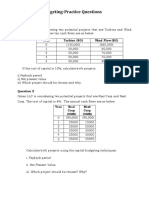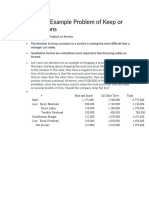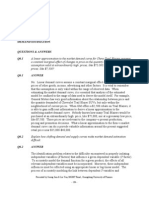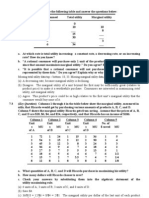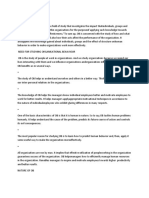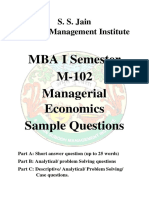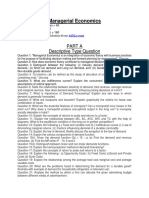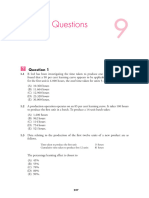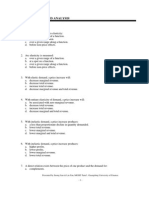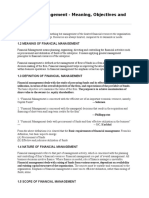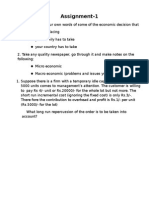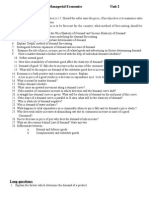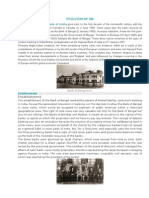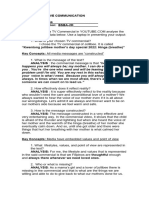Managerial Economics: Numerical Problems
Managerial Economics: Numerical Problems
Uploaded by
archana_anuragiCopyright:
Available Formats
Managerial Economics: Numerical Problems
Managerial Economics: Numerical Problems
Uploaded by
archana_anuragiOriginal Description:
Original Title
Copyright
Available Formats
Share this document
Did you find this document useful?
Is this content inappropriate?
Copyright:
Available Formats
Managerial Economics: Numerical Problems
Managerial Economics: Numerical Problems
Uploaded by
archana_anuragiCopyright:
Available Formats
Managerial Economics
Numerical Problems
I. DEMAND AND ELASTICITY OF DEMAND Problem 1: T e !ollo"ing are #eman# an# su$$l% e&ua'ions o! a $en manu!ac'urer. Qd = 5,00,000 50, 000 P Qs = -1,00,000 + 1,00,000 P Fin#: 1. at what average price, level of demand is eq al to !ero. ". #t what average price, level of s ppl$ is eq al to !ero. %. &alc late the eq ili'ri m price and q antit$. Problem (: A $ublis ing com$an% as ' e !ollo"ing #eman# !unc'ion. Q= 5000-(000P +0.0" Pop + 0.5 )+ 1.5 # *here Q= q antit$ demanded, P is the price, Pop is pop lation, ) is the disposa'le income per ho sehold, # is the advertisement e+pendit re. 1. ,ind o t the demand if P=10, pop. is 10,00,000, )= %0,000 and #= 10,000. ". )f the other varia'les 'eing the same, advertising e+pendit re goes p to -s. 15,000, what wo ld 'e the new demand. Problem ): /0s 1harath #irlines is a regional airlines compan$ providing sh ttle service 'etween 2agp r and 3$dera'ad. #n anal$sis of the monthl$ demand for service has revealed the following demand relationship. Q= "4,000-500P-"50Pog+"00)'-50005 *here Q is q antit$ meas red as n m'er of passengers per month, P is price in 65 dollars, Pog is price inde+ 7188%-8( =19, )' is an inde+ of ' siness activit$, and 5 is a 'inar$ or d mm$ varia'le eq al 1 in s mmer months and 0 otherwise. 1. :etermine the demand c rve facing the airline d ring the winter month of ;an ar$ if Pog=(, )' = "50 ". :etermine the demand c rve facing the airline compan$, q antit$ demanded, and total reven es d ring the s mmer month of ; l$ if P=<100 and all other price-related and ' siness activit$ varia'les are as specified previo sl$. Problem *= # review of ind str$ wide data for the >ell$ and >am man fact ring ind str$ s ggests the following ind str$ s ppl$ f nction= Q= -58,000,000 + 5,00,000 P- ",50,000 Pl 5,00,000 P? +"0,00,000 * *here Q is cases s pplied per $ear, P is wholesale price per case, Pl is average price paid to ns?illed la'o r, P? is average price of capital 7in per cent9, * is weather as inches of rainfall. 1. :etermine the ind str$ s ppl$ c rve for a recent $ear when Pl =<(, P? = 10@, * ="0. 5how the ind str$ s ppl$ c rve with Q e+pressed as a f nction of P and P as a f nction of Q.
". &alc late the q antit$ s pplied '$ the ind str$ at prices <50, <40, and <A0 per case. %. &alc late the prices necessar$ to generate a s ppl$ of ( million, 4 million and B million cases. Problem +: Cashi?a Dimited man fact res an a tomatic camera that c rrentl$ sells at 5<80. 5ales vol me is a'o t ",000 cameras per month in a cit$. # close competitor, /inolta, has c t the price of a similar camera it ma?es from 65< 100 to 65<B0. Cashi?aEs economist has estimated the arc cross elasticit$ of demand 'etween the two rival firmsE prod cts at a'o t 0.(, given c rrent incomes and price levels. *hat impact, if an$, will the action '$ /inolta have on the total reven e generated '$ Cahi?a, if it leaves its c rrent price nchanged. C#53)F# /)2GDH# P1$ = 80 P1m = 100 Q1$ = ",000 P"m = B0 Q"$ = to 'e determined &ross elasticit$ of demand = 0.( Problem ,: 1a>a> #ppliances Dtd. man fact res a line of microwave ovens costing 65<500 each. )ts sales have averaged a'o t 4,000 nits per month d ring "001. )n ; ne "00", 1a>a>Es closest competitor DI had c t its ovenEs price from 65<400 to 65<(50. 1a>a> noticed that its sales vol me declined to (,500 nits per month after the price c t '$ its rival DI. 1. *hat is the arc cross price elasticit$ of demand 'etween the two. ". *o ld $o sa$ that these two firms are ver$ close competitors. %. )f 1a>a> ?nows that the arc price elasticit$ of demand for its ovens is %.0, what price it wo ld have charged to sell same n m'er of nits it did 'efore its rival DI resorted to a price c t. Problem -: Price elasticit$ of personal comp ter of *ipro is estimated to 'e ".". )f the price of the P& declines '$ "0@, what wo ld 'e the e+pected percentage increase in the q antit$ of P&s sold '$ *ipro. Problem .: #m l Dtd. has red ced price of a pop lar 'rand cheese from 65<"."5 to 65<1.A5 a nit. #s a res lt, the firmEs sales of this 'rand of cheese rose from 1,500 nits a da$ to 1,B00 nits per da$. &omp te the arc price elasticit$ of demand over the price and q antit$. Problem /: )n 2avi / m'ai, the s 'wa$ fare has > st 'een increased from a level of -s. 50 to -s. 100 per ride for commercial vehicles with 4 and a'ove wheels. #s a res lt, the transit a thorit$ noted a decline in the sage '$ this categor$ '$ %0@. 1. &omp te the price elasticit$ of demand for the s 'wa$ se. ". )f the old price were restored, what wo ld 'e the impact. *h$. Problem 10: :emand for mo'ile phone handsets '$ a pop lar compan$ in 1angalore cit$ is estimated to 'e Qd = ",50,000- %5P. )f this relationship is appro+imatel$ valid for ne+t $ear also, 1. 3ow man$ mo'ile phones wo ld 'e demanded at a price of -s. ",000, (,000, and 4,000 a set. ". &omp te the arc price elasticit$ 'etween ",000 and (,000J (,000 and 4,000. %. &alc late point elasticit$ at ",000, (,000 and 4,000. (. )f last $ear "5,000 nits were sold, what wo ld have 'een the average price. "
5. *hat is the highest theoretical price for the mo'ile handset in 1angalore for this seller. Problem 11: )f the marginal reven e from a prod ct is -s. 15, and the price elasticit$ of demand is 1.", what is the price of the prod ct. Problem 1(: )f the price elasticit$ of demand for ca'le HK connection is 1.5, and that for movies in local theatre is less than 1 7sa$, 0.49, what strateg$ sho ld the ca'le operator follow for initial hoo? ps. Problem 1): Hhe demand f nction for wall cloc?s in a cit$ has 'een estimated to 'e Q= "000 +15C-5.5P *here C is income in tho sand r pees, Q is q antit$ in nits, and P is nit price. *hen P=150, $ =15, find 1. Price elasticit$ of demand ". )ncome elasticit$ of demand Problem 1*: Hwo goods have a cross elasticit$ of +1." 1. *o ld descri'e them as s 'stit tes or compliments. Iive e+amples for s pporting the categor$ that $o chose. ". )f price of one of the two rises '$ 5@, ceteris pari' s, what happens to the Qd of the other. Problem 1* : )n an attempt to increase reven e and profits, a firm is considering a (@ increase in price and an 11@ increase in advertising. )f the price elasticit$ of demand is 1.5 and the advertising elasticit$ of demand is +0.4, wo ld $o e+pect an increase or decrease in total reven es. Problem 1+:Hhe demand for l nches in an instit te canteen was estimated to 'e Q= 14,(15."1-"4".A(%P, where Q= l nches served, P= price in r pees. 1. &omp te the price elasticit$ of demand at a price of -s. (0, -s.50 per l nch ". *hat is the arc price elasticit$ of demand 'etween the prices (0 and 50. Problem 1,: Gver the past si+ months, &linic 5hampoo has normall$ had sales of 500 cartons of sachets of hair conditioner per wee?. Gn the wee?s when 3ead and 5ho lders red ced its price from -s. 10 to -s. B a nit, &linicEs sales declined to %00 cartons. 1. *hat is the arc elasticit$ of demand 'etween them. ". )f 3ead and 5ho lders had increased its price to -s. 1", what wo ld have 'een its impact on &linic. %. *hat does the evidence indicate a'o t relationship 'etween the two. Problem 1-: Pepsodent sells a tooth'r sh for -s."5. )ts sales have averaged B,000 nits per month over the last $ear. -ecentl$, its close competitor, &olgate, red ced the price of its prod ct from -s. %5 to -s. %0 per tooth'r sh. #s a res lt, PepsodentEs sales declined '$ 1,500 nits per month. 1. *hat is their cross elasticit$. *hat relationship it indicates. ". )f Pepsodent ?nows that it has a cross elasticit$ of 1.5 with &olgate, how m ch it sho ld now charge to restore previo s sales after the price c t '$ &olgate. 7#ss me &olgate retains its price at -s. %0 itself and does not retaliate9. %. *hat is the total monthl$ reven e of Pepsodent 'efore and after the price change in 7"9 a'ove.
(. )s the res lt in part 7%9 a'ove necessaril$ desira'le. *hat other factors wo ld have to 'e ta?en into consideration. Problem 1.: L1eca se of the #merican love affair with driving the a tomo'ile, increases in the price of gasoline will not affect cons mptionM. *hat t$pe of demand c rve does this statement impl$. :o $o 'elieve this is tr e. *h$. Problem 1/: )f the price of P&s declines '$ "0 per cent and the total reven e from the sale of P&s rises, what can $o sa$ a'o t the price elasticit$ of demand. *ill this price red ction necessaril$ lead to an increase in profits for P& man fact rer.
I.
COST ANALYSIS
Problem 1 # monopol$ has estimated the following demand f nction for his prod ct. Q= 1,"0,000-10,000 P *here Q and P are q antit$ and price of the prod ct respectivel$. Hhe firmEs fi+ed costs 7,&9 are -s.1", 000, and varia'le costs 7K&9 are -s. 1.50 per nit. ,ind #n eq ation of the total reven e 7H-9 f nction in terms of Q 1. #n eq ation of H- f nction in terms of Q ". 5pecif$ the marginal reven e 7/-9 f nction %. *rite an eq ation for the total costs 7H&9 f nction in terms of Q (. 5pecif$ the marginal cost 7/&9 f nction 5. *rite the eq ation for the total profits in terms of Q. at what level of o tp t 7Q9 are the total profits ma+imised. *hat is the price at that level. *hat are the total profits at this o tp t level. Problem ( Gnl$ and Gnl$ )nc. is a monopolist. Hhe demand f nction for the prod ct is estimated to 'e Q= 40-0.(P+4C+"#, where Q= q antit$ of nits sold, P= price0 nit, C= per capita disposa'le personal income, #= advertisement e+pendit re. Hhe firmEs #verage Karia'le &ost is given '$ #K& = Q"-10Q+40 (
C=% and #=% for the period nder st d$. 1. )f fi+ed costs = -s. 1000, derive the firmEs total and marginal cost f nctions ". :erive total reven e and marginal reven e f nctions for the firm %. &alc late the profit ma+imising level of price and o tp t (. *hat profit or loss will Gne and Gnl$ earn. 5. )f fi+ed costs were -s. 1,"00, how wo ld the answers change for 7a9 thro gh 7d9. Problem ) /0s - pa N &o. Dtd. Fol?ata, is a hosier$ N ?nitwear man fact ring compan$. Presentl$, it is a'le to sell "0,000 ?idsE nits of nderwear per $ear at an average price of -s. 10 per nit. ,i+ed costs eq al -s. 40,000, and total varia'le costs eq al -s. 1,"0,000. )ts prod ction department has estimated that a 10@ increase in o tp t wo ld not affect the fi+ed costs, ' t wo ld red ce average varia'le costs '$ (0 paise. - paEs mar?eting department intends the compan$Es ratification for a 5@ red ction in price to 'oost sales, H-, and profits. Hhe arc elasticit$ of demand is estimated at ".0 1. Oval ate the impact of the proposal to c t prices on a9 H-, '9 H&, and c9 Hotal profits ". )f #K& is ass med to remain constant over a 10@ increase in o tp t, eval ate the effects of the proposed price c t on the total profits. Problem * #n electrical appliances man fact ring compan$ located in P n>a' intends to have goods prod ced at m ltiplant alternative rather than the e+isting centralised prod ction facilit$. Hhis follows rising transportation costs and goods demand in 5o th and *estern parts of the co ntr$ as well as some parts of the Oastern )ndia. Hhe single-firm reven e and prod ction pl s transportation cost c rves are= #- = 7P9 = 8(0-0.0"Q H& = ",50,000 +(0Q + 0.01 Q" ,ind whether the single-plant option is 'etter or it m st consider m lti-plant option in vario s regions of )ndia. Problem + #n a tomo'ile headlamp 7halogen9 man fact rer plans to start a new prod ction facilit$. 1ased on the preliminar$ information from the acco nts cons ltant, the compan$ needs an estimated -s. ",50,000 on fi+ed factors per month, and average varia'le costs is e+pected to follow a f nction #K&=10+0.01Q 5
*here #K& is the average varia'le costs 7in r pees9 and Q is the monthl$ prod ction in nits. 1. Ostimate total costs 7H&9 and average total costs 7#&9 for the first $ear at a pro>ected vol me of (,000 ' l's. ". #n increase in prod ctivit$ 'eca se of greater e+perience d ring the first $ear res lted in a s 'stantial cost saving for the compan$. Ostimate the effect of learning on #verage &osts if act al cost was -s. 5, "", 500 at an act al vol me of 5,000 ' l's. Problem , &eat P)ndiaQ Dtd. man fact res scooter t$res c rrentl$ operating with a centralised prod ction facilit$. *ith a view to improve its service to its e+isting and prospective c stomers, it is planning to go for a m lti-plant prod ction and decide on the plant si!e 'ased on the e+pected 'enefits and costs. Hhe demand and cost f nctions are as nder= P="00-0.0000%Q H&=AB,1",500 + 100Q +0.0000"Q" 5ho ld the firm contin e with its e+isting facilit$ or start steps to switch over to a m lti-plant option. Problem &rown /fg. &o., developed a niq e design of an e+ec tive chair in :ecem'er "00% that alone is approved c rrentl$ '$ a gro p of proven ph$siotherapists of )ndia as the 'est for wor?aholicsE 'ac?. #ss me that it ta?es " $ears for &rownEs competitors to prod ce similar chairs 7 nfort natel$, this model was not immediatel$ patented, and its rivals made h ge investments within a monthEs time of the commercial prod ction and sale '$ &rown9, and compete with it in the mar?et. Hhe reven e and cost c rves for &rown are given as nder= H- = "0,000Q-15.4 Q" H& = (,00,000+(,4(0Q+10 Q" 7where H& incl des ris?-ad> sted normal rate of ret rn9 *hat sho ld 'e &rownEs short and long-term strategies 7hint= in short-term, it is a /G2GPGDC, in the long term, it operates in a monopolistic competition9 of price-o tp t. *hat wo ld 'e the price-o tp t conditions ass ming it 'ecomes a perfect mar?et after some time 7longterm9. Problem . # pain relieving spra$ called -eli5pra$, an GH& dr g, is 'eing recommended c rrentl$ onl$ '$ -/Ps and doctors. Hhe compan$ wants to e+periment an advertisement thro gh an ad agenc$ /0s Profit / ltiplier, 4
feat ring the worldEs renowned mega cric?eter from )ndia. Hhe agenc$ charges -s. 5,00,000 for the advertisement per month. Hhe c rrent demand is e+pected to do 'le in a month if -eli5Pra$ adopts this sale promotional strateg$. Hhe demand and cost f nctions c rrentl$ for the firm are= Q = "5,000-100PJ H& =",50,000+50Q Gr P = "50-0.01Q :o $o > stif$ the advertisement.
You might also like
- Introduction To Banking and Financial Markets - Unit 5 - Mid Term QuizDocument5 pagesIntroduction To Banking and Financial Markets - Unit 5 - Mid Term Quizprithvirajdk7No ratings yet
- Chapter 18 Simplex-Based Sensitivity Analysis and DualityDocument20 pagesChapter 18 Simplex-Based Sensitivity Analysis and DualityTito TitoNo ratings yet
- Case Study PPDocument3 pagesCase Study PParchana_anuragi100% (2)
- NLP - 92 Hypnotic Sales LettersDocument183 pagesNLP - 92 Hypnotic Sales LettersdamagedclydieNo ratings yet
- Chap 3 Two Variable Regression Model The Problem of EstimationDocument35 pagesChap 3 Two Variable Regression Model The Problem of EstimationSamina AhmeddinNo ratings yet
- Good News For Farming Be Bad For FarmersDocument14 pagesGood News For Farming Be Bad For FarmersAlisha Sthapit100% (1)
- Linear Programming Applications in Marketing, Finance and Operations ManagementDocument12 pagesLinear Programming Applications in Marketing, Finance and Operations ManagementMarwa HassanNo ratings yet
- Case Studies On Relevant CostingDocument2 pagesCase Studies On Relevant CostingZuny Doll100% (1)
- Practice Questions On Demand Estimation LatestDocument6 pagesPractice Questions On Demand Estimation Latestimylviva100% (2)
- Capital-Budgeting-Practice QuestionsDocument3 pagesCapital-Budgeting-Practice QuestionsMohga .FNo ratings yet
- Problem Set Time Value of MoneyDocument5 pagesProblem Set Time Value of MoneyRohit SharmaNo ratings yet
- Suggested Homework AnsDocument6 pagesSuggested Homework AnsFeric KhongNo ratings yet
- Discussion - Example Problem of Keep or Drop DecisionsDocument2 pagesDiscussion - Example Problem of Keep or Drop DecisionsGiselle Martinez0% (1)
- Questions National Income Accounting With KeyDocument6 pagesQuestions National Income Accounting With Keyaditi shuklaNo ratings yet
- Solutions Chapter 5Document36 pagesSolutions Chapter 5Youssef Afkir100% (5)
- Research Report Format-MBADocument6 pagesResearch Report Format-MBAarchana_anuragi100% (1)
- MKTG 1199 MCQ Practice QuestionsDocument24 pagesMKTG 1199 MCQ Practice QuestionsLiang BochengNo ratings yet
- Chapter 4: The Theory of Individual Behavior Answers To Questions and ProblemsDocument11 pagesChapter 4: The Theory of Individual Behavior Answers To Questions and ProblemsAmal IriansahNo ratings yet
- Chap 5-Elasticity and Its ApplicationDocument40 pagesChap 5-Elasticity and Its ApplicationKhánh AnNo ratings yet
- TranshipmentDocument12 pagesTranshipmentSachin YadavNo ratings yet
- CHAPTER 6 - Managing in Competitive, Monopolistic, and Monopolistically Competitive Markets Learning ObjectivesDocument13 pagesCHAPTER 6 - Managing in Competitive, Monopolistic, and Monopolistically Competitive Markets Learning ObjectivesJericho James Madrigal CorpuzNo ratings yet
- Managerial Economics Lecture NotesDocument45 pagesManagerial Economics Lecture Notessherryl cao100% (2)
- Demand Estimation and Forecasting - LecturenotesDocument33 pagesDemand Estimation and Forecasting - LecturenotesRahul Singh100% (1)
- RatioDocument24 pagesRatioSadika KhanNo ratings yet
- 18e Key Question Answers CH 7Document2 pages18e Key Question Answers CH 7AbdullahMughalNo ratings yet
- NUMERICAL QUESTIONS Consumer BehaviourDocument2 pagesNUMERICAL QUESTIONS Consumer BehaviourIsmith Pokhrel33% (3)
- Practice Questions For Managerial EconomicsDocument4 pagesPractice Questions For Managerial Economicsaritra mondalNo ratings yet
- 0 1Document4 pages0 1Sayantan HalderNo ratings yet
- Case Study: "Aashiyana" An Ideal Residential SocietyBy: Ajay MishraAsst. Professor JSSGIW Faculty of Management, BhopalDocument2 pagesCase Study: "Aashiyana" An Ideal Residential SocietyBy: Ajay MishraAsst. Professor JSSGIW Faculty of Management, BhopalAjay MishraNo ratings yet
- 5Document16 pages5abadi gebruNo ratings yet
- Nature of ObDocument3 pagesNature of ObLords PorseenaNo ratings yet
- Mixed StreamsDocument15 pagesMixed StreamsYejiNo ratings yet
- Chapter 2 in Managerial EconomicDocument54 pagesChapter 2 in Managerial EconomicmyraNo ratings yet
- Asymmetric Information and Organizational DesignDocument71 pagesAsymmetric Information and Organizational Designmark yosoresNo ratings yet
- Managerial Economics Quiz 2Document8 pagesManagerial Economics Quiz 2Junayed AzizNo ratings yet
- Printing Basics Excel Test Answers: Following Methods Will Allow You To Access This View?Document26 pagesPrinting Basics Excel Test Answers: Following Methods Will Allow You To Access This View?Rosemarie CruzNo ratings yet
- Theory of Demand & Supply Revision NotesDocument58 pagesTheory of Demand & Supply Revision Noteswosihit898No ratings yet
- Chapter 11: Development Policymaking and The Roles of Market, State, and Civil SocietyDocument5 pagesChapter 11: Development Policymaking and The Roles of Market, State, and Civil SocietyMarc BuenoNo ratings yet
- Test Bank Chapter1Document4 pagesTest Bank Chapter1shawkt100% (1)
- Business Economics Meaning Nature Scope and Objectives PDFDocument6 pagesBusiness Economics Meaning Nature Scope and Objectives PDFAlex Garfield50% (2)
- CH.3 Managerial Economics For NMDocument28 pagesCH.3 Managerial Economics For NMDannyelle SorredaNo ratings yet
- Cost ConceptDocument22 pagesCost ConceptgurtejtestingNo ratings yet
- Differences Between US GAAP, Indian GAAP and International Accounting StandardsDocument7 pagesDifferences Between US GAAP, Indian GAAP and International Accounting StandardsAmitesh PandeyNo ratings yet
- FIN 310 - Chapter 3 Questions With AnswersDocument8 pagesFIN 310 - Chapter 3 Questions With AnswersKelby BahrNo ratings yet
- Irctc Ipo PPT FM PDFDocument12 pagesIrctc Ipo PPT FM PDFAnshita JainNo ratings yet
- MBA I Semester M-102 Managerial Economics Sample Questions: S. S. Jain Subodh Management InstituteDocument14 pagesMBA I Semester M-102 Managerial Economics Sample Questions: S. S. Jain Subodh Management Institutesubhojit6660No ratings yet
- Chapter 7 Lecture - Costs and Cost MinimizationDocument9 pagesChapter 7 Lecture - Costs and Cost MinimizationMayank PatelNo ratings yet
- Managerial Economics QuizDocument101 pagesManagerial Economics QuizDheeraj GandhiNo ratings yet
- Chapter 04 Risk, Return, and The Portfolio TheoryDocument55 pagesChapter 04 Risk, Return, and The Portfolio TheoryAG100% (1)
- Managerial Economics MB004 Question PDFDocument33 pagesManagerial Economics MB004 Question PDFGeo Joy100% (1)
- 1.2 National Income Accounting PDFDocument24 pages1.2 National Income Accounting PDFdivya91% (11)
- CONADEV - Chapter 5Document16 pagesCONADEV - Chapter 5Lalaine ReyesNo ratings yet
- What Is The Production Possibility Frontier?Document4 pagesWhat Is The Production Possibility Frontier?itsmenatoyNo ratings yet
- Production Order Quantity Model: Used When Inventory Builds UpDocument7 pagesProduction Order Quantity Model: Used When Inventory Builds UpANKITA LUTHRA EPGDIB 2018-20No ratings yet
- Estimating Demand FunctionDocument45 pagesEstimating Demand FunctionManisha AdliNo ratings yet
- CH-6-Efficient Capital MarketsDocument9 pagesCH-6-Efficient Capital MarketsMoin khanNo ratings yet
- Margin Trading, Short Selling, and Return Calculation: BF 2201 Investments Fall 2021 Professor Qifei ZhuDocument47 pagesMargin Trading, Short Selling, and Return Calculation: BF 2201 Investments Fall 2021 Professor Qifei ZhuHenry ZhengNo ratings yet
- Chap 10 QuizDocument29 pagesChap 10 QuizLeneth AngtiampoNo ratings yet
- Learning Curve ExercisesDocument6 pagesLearning Curve ExercisesRosele CabañelezNo ratings yet
- Elasticity Practice TestDocument8 pagesElasticity Practice TestAmir NelsonNo ratings yet
- Elasticities Practice ProblemsDocument3 pagesElasticities Practice Problemsbalachmalik60% (5)
- Testbank Chapter5 NewDocument13 pagesTestbank Chapter5 NewAhmadYaseenNo ratings yet
- 4 Seminar D + S_platformaDocument3 pages4 Seminar D + S_platformaKsusha KsuNo ratings yet
- Multiple Choice: This Activity Contains 20 QuestionsDocument5 pagesMultiple Choice: This Activity Contains 20 Questionsmas_999No ratings yet
- Financial ManagementDocument6 pagesFinancial Managementarchana_anuragiNo ratings yet
- Working Capital ManagementDocument6 pagesWorking Capital Managementarchana_anuragiNo ratings yet
- Ansoff Growth MatrixDocument10 pagesAnsoff Growth Matrixarchana_anuragiNo ratings yet
- Summer Training Project Report ON: Consumer Perception AT Amul ProductDocument117 pagesSummer Training Project Report ON: Consumer Perception AT Amul Productarchana_anuragiNo ratings yet
- Institute of Chartered Accountant of India (ICAI) Are As FollowsDocument8 pagesInstitute of Chartered Accountant of India (ICAI) Are As Followsarchana_anuragiNo ratings yet
- Receivables Management: © Tata Mcgraw-Hill Publishing Company Limited, Financial ManagementDocument46 pagesReceivables Management: © Tata Mcgraw-Hill Publishing Company Limited, Financial Managementarchana_anuragi100% (1)
- Cost Accounting Unit 1Document16 pagesCost Accounting Unit 1archana_anuragi100% (1)
- Unit - 1Document8 pagesUnit - 1arjunmba119624No ratings yet
- AssignmentDocument4 pagesAssignmentarchana_anuragiNo ratings yet
- Research Project Report ON: Consumer Buying Behaviour and Brand Perception in Shopping Malls of IndiaDocument109 pagesResearch Project Report ON: Consumer Buying Behaviour and Brand Perception in Shopping Malls of Indiaarchana_anuragiNo ratings yet
- QB For Me Unit 2Document4 pagesQB For Me Unit 2archana_anuragiNo ratings yet
- Evolution of SbiDocument6 pagesEvolution of Sbiarchana_anuragiNo ratings yet
- Functions of Financial ManagementDocument6 pagesFunctions of Financial Managementarchana_anuragi100% (2)
- Unemployment Statistics in IndiaDocument2 pagesUnemployment Statistics in Indiaarchana_anuragiNo ratings yet
- Test Centre List (F-15 MAT)Document2 pagesTest Centre List (F-15 MAT)archana_anuragiNo ratings yet
- Examination Regulations: Registration For ExaminationsDocument4 pagesExamination Regulations: Registration For Examinationsarchana_anuragiNo ratings yet
- 3rd Sessional For BBA.Document1 page3rd Sessional For BBA.archana_anuragiNo ratings yet
- GE 107 PURPOSIVE COMMUNICATION (TV Commercial Analysis)Document3 pagesGE 107 PURPOSIVE COMMUNICATION (TV Commercial Analysis)Niña VelinaNo ratings yet
- Influence of Culture and Cross Culture On ConsumerDocument39 pagesInfluence of Culture and Cross Culture On ConsumerdurraizaliNo ratings yet
- MRK SessionDocument33 pagesMRK SessionTz SenNo ratings yet
- Business PlanDocument5 pagesBusiness PlanYasir Javed SheikhNo ratings yet
- Merchant Cash Factoring Business Cash LoansDocument2 pagesMerchant Cash Factoring Business Cash LoansMerchantCashinAdvanceNo ratings yet
- AmulDocument13 pagesAmulDipti Sahu100% (1)
- Mark-3480 Project ReportDocument16 pagesMark-3480 Project ReportRitesh AhujaNo ratings yet
- Working With The Media: Chapter TenDocument12 pagesWorking With The Media: Chapter TenRaluca MarinescuNo ratings yet
- 2014 Springfield Puerto Rican ParadeDocument5 pages2014 Springfield Puerto Rican ParadeRomanMatiasNo ratings yet
- Material Audiovisual de InglésDocument60 pagesMaterial Audiovisual de InglésPodrida Raptor100% (1)
- Sample Business Plan F&BDocument26 pagesSample Business Plan F&BAnneHumayraAnasNo ratings yet
- Elc590 Pitching - SampleDocument1 pageElc590 Pitching - SampleFatini zulkiflyNo ratings yet
- Ram NavmiDocument419 pagesRam NavmisaraswatiNo ratings yet
- Budget AllocationDocument21 pagesBudget AllocationMeenal Pendse100% (1)
- Chapter 8 - Coke Zero: True/FalseDocument3 pagesChapter 8 - Coke Zero: True/FalseHyChoNo ratings yet
- Marketing Case Analyses Prithvi ElectricalsDocument2 pagesMarketing Case Analyses Prithvi ElectricalsAman PoddarNo ratings yet
- Vault Guide To International CareersDocument208 pagesVault Guide To International Careerspunit_sonikaNo ratings yet
- Flexibleplaybook 2013 r6 OptDocument140 pagesFlexibleplaybook 2013 r6 OptMohamad IkhwanNo ratings yet
- BRKMPL 2102Document104 pagesBRKMPL 2102Ruei Yu ZengNo ratings yet
- GITEX 09 Sponsorship Package - 2 Sep PDFDocument7 pagesGITEX 09 Sponsorship Package - 2 Sep PDFVaishaliduaNo ratings yet
- The Process of 3D AnimationDocument14 pagesThe Process of 3D AnimationgdayanandamNo ratings yet
- 153-Article Text-590-4-10-20221121Document11 pages153-Article Text-590-4-10-20221121Muhammad FachrizalNo ratings yet
- Marketing End Term Project Presentation On StarbucksDocument26 pagesMarketing End Term Project Presentation On StarbucksWisam AtilNo ratings yet
- McCafe Marketing PlanDocument23 pagesMcCafe Marketing PlanMikail Gasanov100% (6)
- Fatboy The Original v. Chapman - ComplaintDocument15 pagesFatboy The Original v. Chapman - ComplaintSarah BursteinNo ratings yet
- Essay - Standardization & Adaptation Marketing StrategiesDocument51 pagesEssay - Standardization & Adaptation Marketing StrategiesAdrian Wong100% (2)
- LO 3 Support Marketing and Promotional ProgramsdocxDocument17 pagesLO 3 Support Marketing and Promotional Programsdocxzed abelNo ratings yet
- Consumer Attitude & MKT Structure (Lecture 4)Document43 pagesConsumer Attitude & MKT Structure (Lecture 4)Deepika AgarwalNo ratings yet









